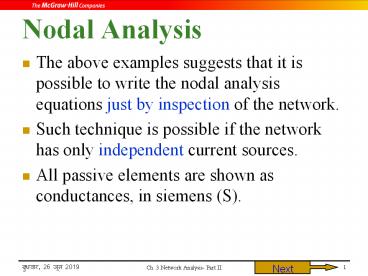Nodal%20Analysis - PowerPoint PPT Presentation
Title:
Nodal%20Analysis
Description:
All off-diagonal elements are negative or zero. Next Next Solution : Next We can write the nodal voltage equation in matrix form, directly by inspection : ... – PowerPoint PPT presentation
Number of Views:105
Avg rating:3.0/5.0
Title: Nodal%20Analysis
1
Nodal Analysis
- The above examples suggests that it is possible
to write the nodal analysis equations just by
inspection of the network. - Such technique is possible if the network has
only independent current sources. - All passive elements are shown as conductances,
in siemens (S).
2
- In case a network contains a practical voltage
source, first convert it into an equivalent
practical current source. - Write the Conductance Matrix, Node-Voltage Matrix
and the Node-Current Source Matrix, in the same
way as in the Mesh Analysis.
3
Example 13
- Let us again tackle Example 12, by writing the
matrix equations just by inspection.
4
Conductance matrix. G11 Self-conductance of
node 1.G12 Mutual conductance between node 1
and 2.
5
- Node-voltage Matrix.
- Node current-source Matrix.
- Note that all the elements on the major diagonal
of matrix G are positive. - All off-diagonal elements are negative or zero.
6
Example 14
- Solve the following network using the nodal
analysis, and determine the current through the
2-S resistor.
7
Solution
8
We can write the nodal voltage equation in matrix
form, directly by inspection
9
Using Calculator, we get
- Finally, the current through 2-S resistor is
10
Example 15
- Find the node voltages in the circuit shown .
11
Solution
First Method
Transform the 13-V source and series 5-S resistor
to an equivalent current source of 65 A and a
parallel resistor of 5 S
12
Now, we can write the nodal equations in matrix
form for the two nodes just by inspection,
Now, from the original circuit shown, we get
13
Second Method
We use the concept of supernode. The voltage
source is enclosed in a region by a dotted line,
as shown in figure. The KCL is then applied to
this closed surface
The KCL equation for node 1 is
For three unknowns, we need another independent
equation. This is obtained from the voltage drop
across the voltage source,
Writing the above equations in matrix form,
14
Solving, we get
Which are the same as obtained by first method.
In general, for the supernode approach, the KCL
equations must be augmented with KVL equations
the number of which is equal to the number of the
floating voltage sources.
15
Choice Between the TWO
- We select a method in which the number of
equations to be solved is less. - The number of equations to be solved in mesh
analysis is - b (n 1)
- The number of equations to be solved in nodal
analysis is - (n 1)

